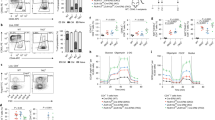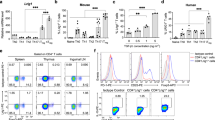Abstract
Immune responses are normally targeted against microbial pathogens and not self-antigens by mechanisms that are only partly understood. Here we define a newly discovered pathway that prevents autoimmunity by limiting the levels on T lymphocytes of a co-stimulatory receptor, the inducible T-cell co-stimulator (ICOS). In sanroque mice homozygous for an M199R mutation in the ROQ domain of Roquin (also known as Rc3h1)1, increased Icos expression on T cells causes the accumulation of lymphocytes that is associated with a lupus-like autoimmune syndrome. Roquin normally limits Icos expression by promoting the degradation of Icos messenger RNA. A conserved segment in the unusually long ICOS 3′ untranslated mRNA is essential for regulation by Roquin. This segment comprises a 47-base-pair minimal region complementary to T-cell-expressed microRNAs including miR-101, the repressive activity of which is disrupted by base-pair inversions predicted to abrogate miR-101 binding. These findings illuminate a critical post-transcriptional pathway within T cells that regulates lymphocyte accumulation and autoimmunity, and highlights the therapeutic potential of partially antagonising the ICOS pathway.
This is a preview of subscription content, access via your institution
Access options
Subscribe to this journal
Receive 51 print issues and online access
$199.00 per year
only $3.90 per issue
Buy this article
- Purchase on Springer Link
- Instant access to full article PDF
Prices may be subject to local taxes which are calculated during checkout




Similar content being viewed by others
References
Vinuesa, C. G. et al. A RING-type ubiquitin ligase family member required to repress follicular helper T cells and autoimmunity. Nature 435, 452–458 (2005)
Matzinger, P. Tolerance, danger, and the extended family. Annu. Rev. Immunol. 12, 991–1045 (1994)
Janeway, C. A. & Bottomly, K. Signals and signs for lymphocyte responses. Cell 76, 275–285 (1994)
Lafferty, K. J., Andrus, L. & Prowse, S. J. Role of lymphokine and antigen in the control of specific T cell responses. Immunol. Rev. 51, 279–314 (1980)
Suh, W. K. et al. The inducible costimulator plays the major costimulatory role in humoral immune responses in the absence of CD28. J. Immunol. 172, 5917–5923 (2004)
Nurieva, R. et al. T-cell tolerance or function is determined by combinatorial costimulatory signals. EMBO J. 25, 2623–2633 (2006)
Bossaller, L. et al. ICOS deficiency is associated with a severe reduction of CXCR5+CD4 germinal center Th cells. J. Immunol. 177, 4927–4932 (2006)
Akiba, H. et al. The role of ICOS in the CXCR5+ follicular B helper T cell maintenance in vivo . J. Immunol. 175, 2340–2348 (2005)
Dong, C. et al. ICOS co-stimulatory receptor is essential for T-cell activation and function. Nature 409, 97–101 (2001)
Dong, C., Temann, U. A. & Flavell, R. A. Cutting edge: critical role of inducible costimulator in germinal center reactions. J. Immunol. 166, 3659–3662 (2001)
McAdam, A. J. et al. ICOS is critical for CD40-mediated antibody class switching. Nature 409, 102–105 (2001)
Tafuri, A. et al. ICOS is essential for effective T-helper-cell responses. Nature 409, 105–109 (2001)
Grimbacher, B. et al. Homozygous loss of ICOS is associated with adult-onset common variable immunodeficiency. Nature Immunol. 4, 261–268 (2003)
Mak, T. W. et al. Costimulation through the inducible costimulator ligand is essential for both T helper and B cell functions in T cell-dependent B cell responses. Nature Immunol. 4, 765–772 (2003)
Wong, S. C., Oh, E., Ng, C. H. & Lam, K. P. Impaired germinal center formation and recall T-cell-dependent immune responses in mice lacking the costimulatory ligand B7–H2. Blood 102, 1381–1388 (2003)
Newbury, S. F., Muhlemann, O. & Stoecklin, G. Turnover in the Alps: an mRNA perspective. Workshops on mechanisms and regulation of mRNA turnover. EMBO Rep. 7, 143–148 (2006)
Barreau, C., Paillard, L. & Osborne, H. B. AU-rich elements and associated factors: are there unifying principles? Nucleic Acids Res. 33, 7138–7150 (2005)
Rajewsky, N. MicroRNA target predictions in animals. Nature Genet. 38 (Suppl). S8–S13 (2006)
John, B. et al. Human MicroRNA targets. PLoS Biol. 2, e363 (2004)
Sethupathy, P., Megraw, M. & Hatzigeorgiou, A. G. A guide through present computational approaches for the identification of mammalian microRNA targets. Nature Methods 3, 881–886 (2006)
Monticelli, S. et al. MicroRNA profiling of the murine hematopoietic system. Genome Biol. 6, R71 (2005)
Jackson, R. J. & Standart, N. How do microRNAs regulate gene expression? Sci. STKE 2007, re1 (2007)
Lim, L. P. et al. Microarray analysis shows that some microRNAs downregulate large numbers of target mRNAs. Nature 433, 769–773 (2005)
Yoshinaga, S. K. et al. T-cell co-stimulation through B7RP-1 and ICOS. Nature 402, 827–832 (1999)
Hutloff, A. et al. ICOS is an inducible T-cell co-stimulator structurally and functionally related to CD28. Nature 397, 263–266 (1999)
Tordjman, R. et al. A neuronal receptor, neuropilin-1, is essential for the initiation of the primary immune response. Nature Immunol. 3, 477–482 (2002)
Bhattacharyya, S. N., Habermacher, R., Martine, U., Closs, E. I. & Filipowicz, W. Relief of microRNA-mediated translational repression in human cells subjected to stress. Cell 125, 1111–1124 (2006)
Jakymiw, A. et al. Autoimmune targeting of key components of RNA interference. Arthritis Res. Ther. 8, R87 (2006)
Scheu, S. Activation of the integrated stress response during T helper cell differentiation. Nature Immunol. 7, 644–651 (2006)
Brudno, M. et al. LAGAN and Multi-LAGAN: efficient tools for large-scale multiple alignment of genomic DNA. Genome Res. 13, 721–731 (2003)
Acknowledgements
We thank R. Parker and J. Liu for the MS2–YFP–NLS plasmids; R. Kroczek and Millennium Pharmaceuticals for Icos-/- mice; Q.-J. Li, M. Davis and C.-Z. Chen for advice with the miRNA experiments; and the ACRF Biomolecular Resource Facility for real-time RT–PCR. This work was supported by the NHMRC, and by a Senior Viertel Medical Research Fellowship to C.G.V.
Author Contributions D.Y., C.C.G. and C.G.V. designed the study; D.Y., A.H.T. and X.H. performed experiments and analyzed the data; V.A., N.S., K.M.G. and D.G.S. helped with experiments; A.H., P.J.L. and K.P.L. provided expertise and advice; and D.Y., C.C.G. and C.G.V. wrote the manuscript.
Author information
Authors and Affiliations
Corresponding author
Ethics declarations
Competing interests
The authors declare no competing financial interests.
Supplementary information
Supplementary Information
This file contains Supplementary Figures 1-12 with Legends and Supplementary Table 1. (PDF 555 kb)
Rights and permissions
About this article
Cite this article
Di Yu, Tan, AM., Hu, X. et al. Roquin represses autoimmunity by limiting inducible T-cell co-stimulator messenger RNA. Nature 450, 299–303 (2007). https://doi.org/10.1038/nature06253
Received:
Accepted:
Issue Date:
DOI: https://doi.org/10.1038/nature06253
This article is cited by
-
The endogenous repertoire harbors self-reactive CD4+ T cell clones that adopt a follicular helper T cell-like phenotype at steady state
Nature Immunology (2023)
-
RBP–RNA interactions in the control of autoimmunity and autoinflammation
Cell Research (2023)
-
Innate immune sensing of pathogens and its post-transcriptional regulations by RNA-binding proteins
Archives of Pharmacal Research (2023)
-
Disrupting Roquin-1 interaction with Regnase-1 induces autoimmunity and enhances antitumor responses
Nature Immunology (2021)
-
Targeting ubiquitin signaling for cancer immunotherapy
Signal Transduction and Targeted Therapy (2021)
Comments
By submitting a comment you agree to abide by our Terms and Community Guidelines. If you find something abusive or that does not comply with our terms or guidelines please flag it as inappropriate.



